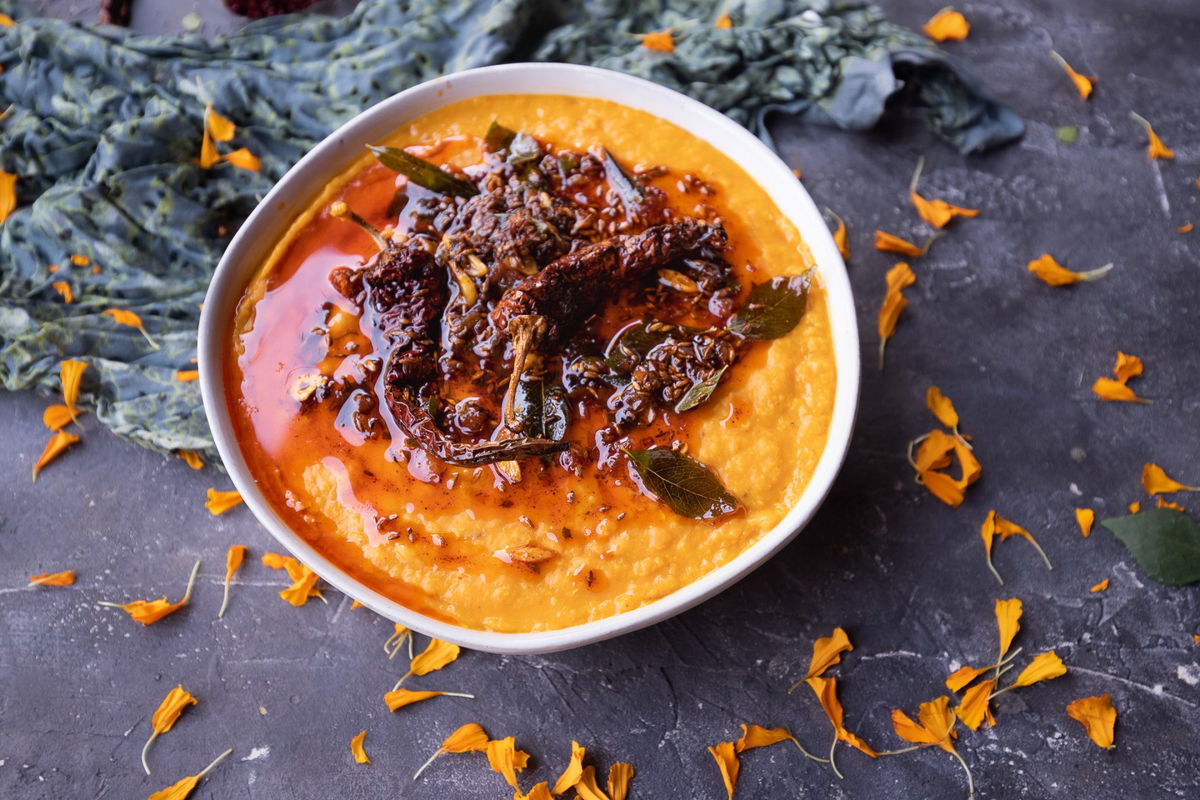Kulcha are a leavened flatbread that has a soft, pillowy texture. Kulcha is very similar to naan. With this recipe, it is possible to make this wonderful bread yourself at home, using either yeast or baking soda for leavening. I’ll also show you how to make it on the stovetop and in the oven.
Both kulcha and naan are leavened flatbreads traditionally cooked in a tandoor. The difference is that naan is typically allowed to rise for several hours as opposed to kulcha, which is typically only allowed to rise for an hour.
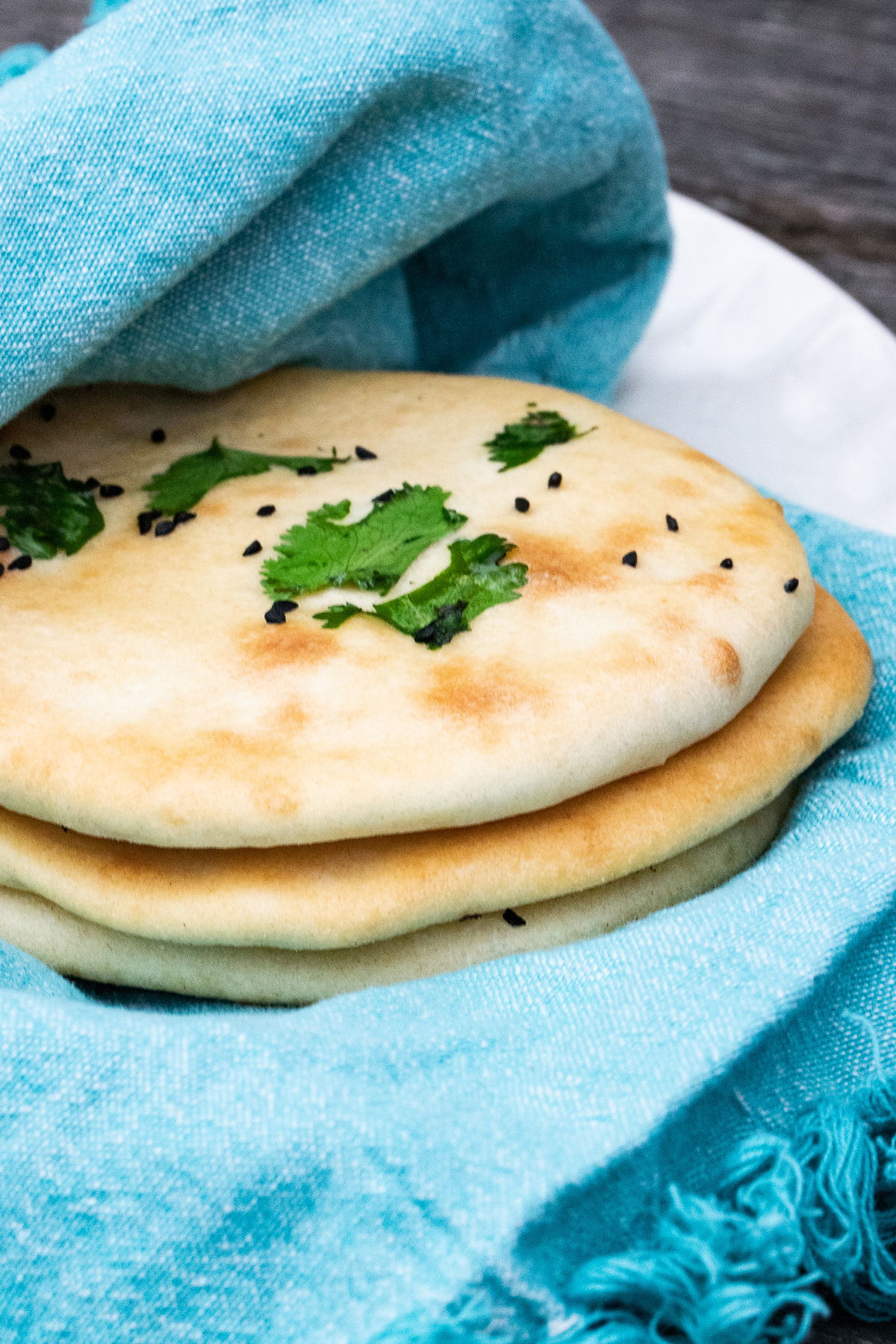
Cooking Methods
The main challenge of making kulcha at home is getting the same type of fluffiness and browning that you would get from a tandoor. A tandoor is a big clay oven that is shaped in a way to provide very high heat. This cooks the bread very fast, allowing it to brown and fluff up.
Oven Versus Skillet
The home oven doesn’t get nearly as hot as a tandoor. But we can achieve similar results by either using the oven’s broiler or by cooking our flatbreads on a cast iron skillet. A good, heavy cast iron skillet is ideal because it will provide very even heating, and, if correctly seasoned, provides a non-stick surface.
I liked cooking these in the oven because they really fluffed up, even more than on the skillet. The oven would also be more convenient if you made a lot of them because you could bake several at a time. However, the skillet proved nice browning. If you wanted to, you could bake them in the oven and then finish them on the skillet to get the best texture and the right look.
Yeast versus Baking Soda
Kulcha is traditionally leavened with yeast. This yeast is provided by a starter that often begins with some yogurt and flour. In this recipe, I use active dry yeast, which is far more convenient.
It has become more common in India to use baking soda and baking powder for leavening. Baking soda provides a quicker rise but imparts a subtle baking soda flavor. Yeast also adds a flavor, but I find the yeasty flavor pleasant and the baking soda flavor slightly unpleasant. I conducted a blind taste test with my family. The difference was obvious only to my mother, who preferred the yeast version.

Rolling Out the Dough
One more technique I tested out was spreading out the dough with my fingers versus using a rolling pin to roll out the dough. When I used the rolling pin, the bread was way fluffier.
Ingredients
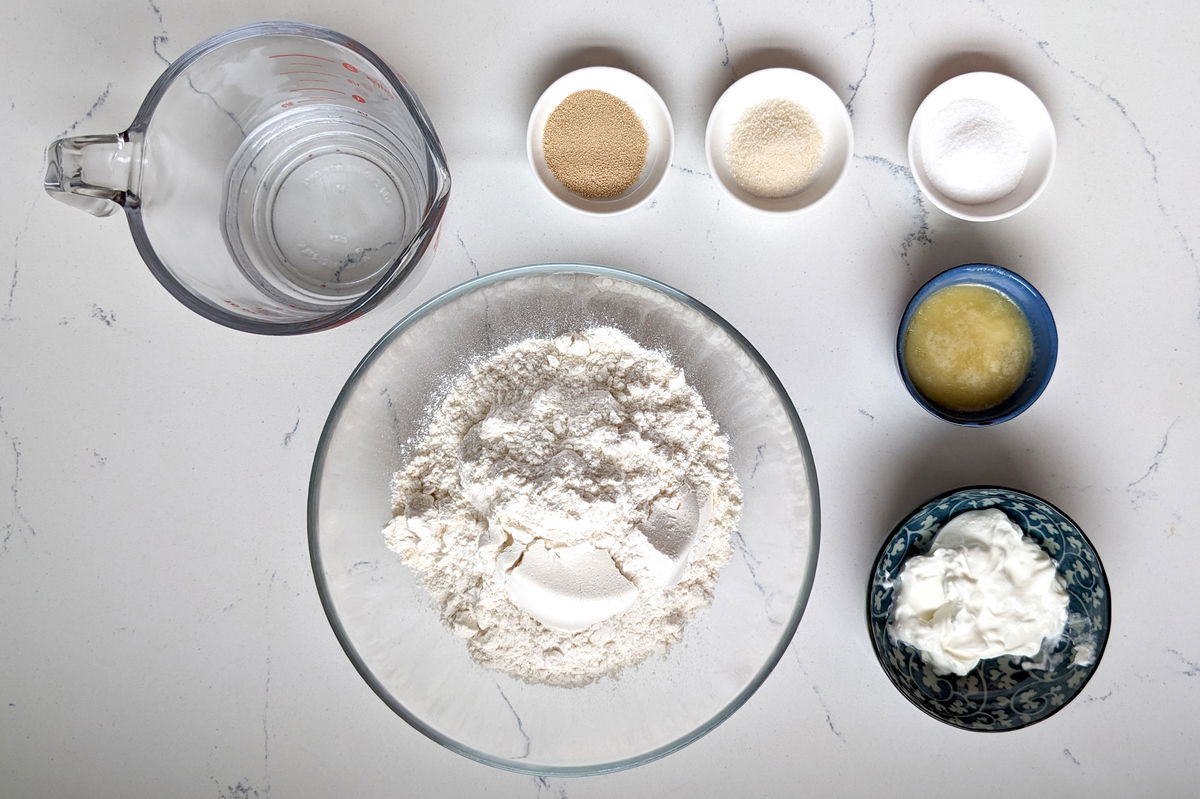
- All Purpose Flour
- Yogurt – softens the dough and adds a bright, tangy flavor. Can sub in milk.
- Salt
- Sugar – for the yeast and to help with browning. Does not add sweetness.
- Ghee or oil – I prefer ghee for the richer flavor. But any kind of neutral oil will work as well. Many people recommend using butter, but kulcha is cooked at a very high temperature, and when I tried butter, I got a brown-butter flavor that was out of place here. It’s important to use an oil that has a high smoke point, as ghee does.
- Yeast for yeast method — I used active dry yeast, which requires activating the yeast. Instant yeast works, too, and doesn’t have to be activated. Whatever yeast you use, you can start by following the instructions on the package.
- Baking soda and baking powder for baking powder method — This is not my preferred method, but I wouldn’t hesitate to make them this way if I didn’t have yeast.
Optionally add whatever spices you like. I used nigella seeds and cilantro, which is a classic combination for a “plain kulcha.” You can also leave this off entirely if you want it completely plain. If you don’t have nigella seeds, try coriander seeds or cumin seeds.

Cooking Tips
- Make sure to knead the dough for the entire 5 minutes. Set a timer! The texture will not come out right if you cut short the kneading.
- Make sure your heat is set to medium-low or even low when cooking on the stovetop or the bottom will burn.
- You start off with a very sticky dough and knead it until it is no longer sticky. You should not be adding flour while kneading, the process of kneading the dough will create the soft, even texture.
- If you are cooking the oven, make sure your baking tray is well greased because it has a strong tendency to stick. Use a spray or brush on some ghee. Even then you may need to use a firm spatula to separate it.
- It’s easy to make different flavors of kulcha, see our onion kulcha recipe one of the most popular variations.
Serving Kulcha
Since Indian meals are typically served with a flatbread, kulcha is like a special treat kind of bread to serve when having guests over. Since it’s not whole wheat, it’s not as healthy of bread as roti or paratha. I like leavened bread like naan and kulcha because they absorb the gravy of a wet shaak more than roti or paratha. They are great with wet curries like palak paneer and chicken jalfrezi.
Freezing and Refrigeration
Kulcha will keep in the refrigerator for a couple of days. Like any bread, it will start to lose its freshness after that.
Freezer Instructions
- Kulcha freezes very well. They will stay fresh in the freezer for up to 3 months. I would double-wrap it to protect against freezer burn and to protect against odor absorption. To make sure they will separate easily after freezing, freeze them on a baking tray. Once frozen solid, remove from tray and stack together. Or separate with some parchment.
- To reheat/defrost: For the best flavor and texture, reheat in the oven for 1 minute at 450°F.
- I often reheat them on the tava. Make sure to brush the tava with a bit of oil or ghee to keep it from sticking. Cook under medium heat for 1-2 minutes on each side. A tava is essentially a thin cast iron skillet. If you don’t have a tava, a cast iron skillet will work for this.
- Some people reheat with a microwave, but this isn’t ideal for texture.
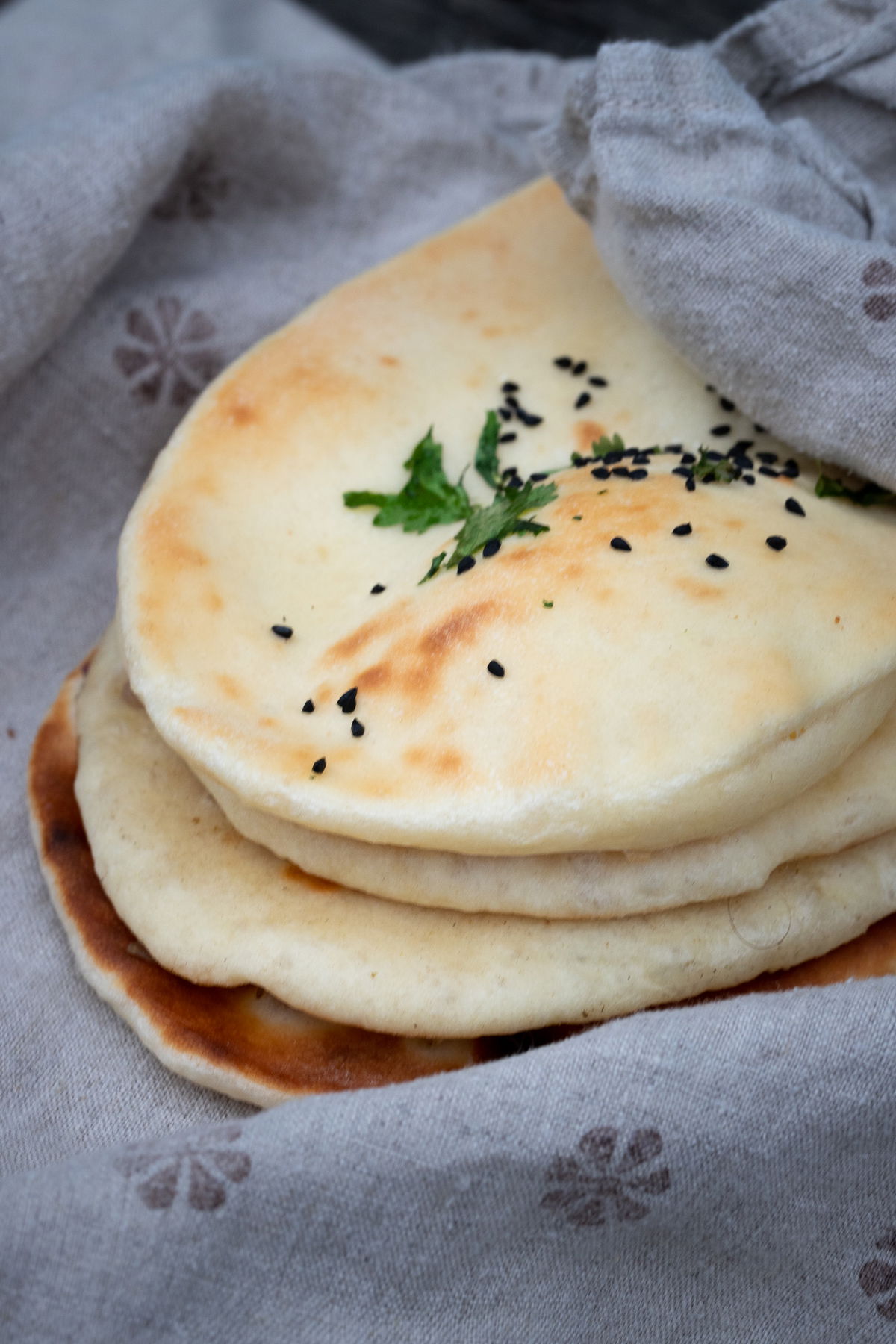
Prepping Ahead
You can make the dough ahead of time and even freeze it for several months. It’s easiest to make the individual dough balls before freezing. Defrost the dough by thawing overnight in the refrigerator, then they are ready to roll out and finish cooking.
Recipe
Homemade Kulcha – With Yeast and Baking Soda Methods
Kulcha are a leavened flatbread that has a soft, pillowy texture.
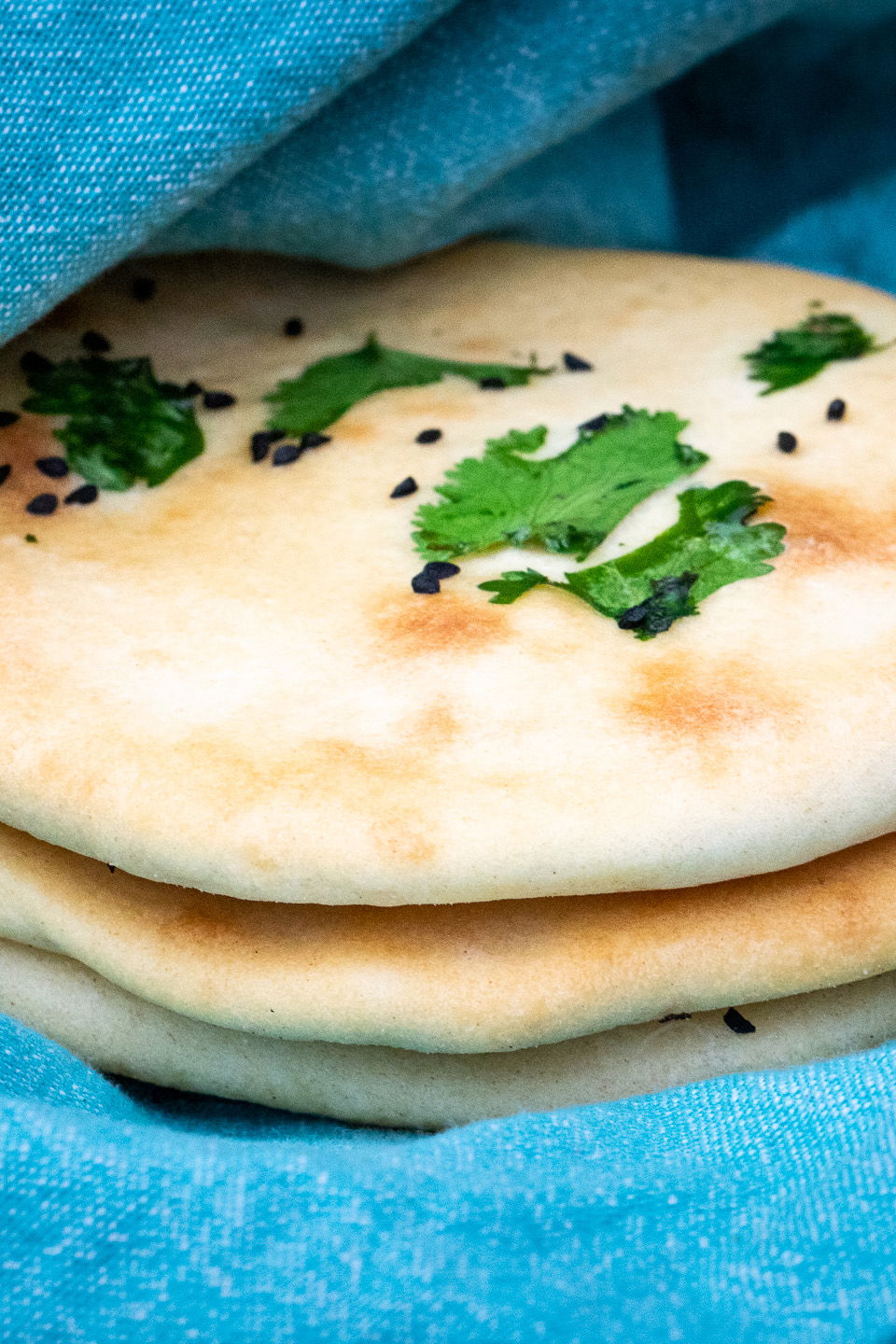
Ingredients
- 2 cups All Purpose Flour (+ extra for rolling)
- 1 tsp salt (or to taste)
- 1 Tbsp ghee or oil (separated into half)
- 1/4 cup Greek yogurt
- 1 tsp active dry yeast ((or ½ tsp baking soda + ½ tsp baking powder))
- 1 tsp nigella seeds
- A few cilantro leaves
- 1/2 cup water
- 3 Tbsp ghee or oil (for brushing the pan and kulcha)
Instructions
- Dissolve 1 tsp of sugar into ¼ cup of warm water. The hottest setting on my tap water is perfect for this but you can heat water on the stove or in the microwave too. It should be slightly hot to the touch, about 110°F to 115° F or (43°C - 46°C)
- Sprinkle the yeast over the sugar water and let the yeast activate for 10 minutes. The yeast should double in size.
- In a large bowl, combine the flour and salt. Then add ½ tbsp of ghee, yogurt, and the yeast mixture. Mix into the flour. Then form a soft and sticky dough, adding a little bit of water at a time. You should knead between ¼ to ½ cup more water. Once the dough is formed, add the remaining ½ tbsp of ghee and knead for 5 minutes.
- Once the dough is kneaded, form a ball by tucking the edges under. Place the dough ball back into the bowl. Cover and set in a warm place to proof for 1 hour or until doubled (you may need more time if you work in a very cold place).
- Divide the dough into eight equal sections and fold each into a ball by tucking the edges under. Keep the sections covered as you work.
- Take one section and roll it into a ¼ inch thick oval (or a circle if you prefer), using as much dry flour as needed to avoid sticking.
- Brush the kulcha with water and sprinkle with nigella seeds and cilantro leaves.
- Heat a cast iron skillet on medium/low heat. Brush the skillet with ghee or oil and add the kulcha, topping side up if using toppings.
- Add 1 Tbsp of water to the skillet next to (not on top) the kulcha. Cover with a lid and let cook for 5 to 6 minutes.
- Brush the top of the kulcha with ghee or oil and flip. Cook for 30 to 60 seconds until golden.
